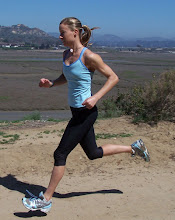No question - triathlon puts some stress on the knees. Even if you're a featherweight, it's only a matter of time before you feel pain or tightness in your knee or hip...unless you're smart about it!
Chances are, if your knees hurt, the cause isn't the knee itself. The most common cause of knee stress or injury is weakness in a muscle group above or behind the knee, or in the hip. "Knee bone connected to the...thigh bone..." Yep, it's true for your whole musculo-skeletal system too.So...You've got to have a strong lateral hip (that squishy area to the side of your gluteus maximus, a.k.a. "bootie"). And, you need balanced strength in the quad and hamstring.
Lateral Hip Strength
When I signed up for my first core strength mentorship in 2004, my right hip was so tight my run became a hobble - and the knee didn't feel much better. The master trainers took a look at my baggy tri shorts, which were slipping dangerously close to my crack-side, and declared my hips too skinny. I tried to balance on one leg and do some movements - and then we were sure I'd neglected my poor little hips.
Within two weeks after this strength workshop (which worked muscles I didn't know I had), my hip and knee pain were gone. One more week, and I ran a PR at Age-group Nationals, even though I hadn't been able to do run training. This was purely due to improved mechanics, flexibility, and core + hip strength.
Here's the number 1 must-do exercise if you run, ride, or play any sport involving running, jumping, hopping, etc.:




...If you have straight hips, this will enhance your waist-to-hip ratio. If you're feeling a little flabby or round, this will trim and tone, smoothing out your hip line. (Who doesn't want a little of that?)
Balanced Quad and Hamstring Strength

To get it, include a squat or lunge (to work the quad) and a hamstring exercise in your routine. If you have current knee pain, DO NOT DO SQUATS YET. Start with a seated 1-leg extension, 2x20 reps, with no weight to light weight.
Then, add a hamstring curl with a swiss ball. This is a gnarly but so-effective solution for keeping the hamstrings and glutes strong, to protect your knees and make you faster.


If riding or running is still a pain in the knee even though you're working the strength, check your shoes!
Running shoes -- Are you running in a "stability" shoe when you should be in a neutral/cushioned shoe? Do you have enough arch support? Do you run on level surfaces? (A road or trail that's cambered - slanted downward to one side - tightens the IT band and lateral knee.)
Cycling shoes -- Are your cleats centered under the ball of your foot? Have you had a good bike fitting recently? Pain in front of the knee (patellar) can mean your seat is too low, or your feet are too far forward. Pain behind the knee can mean your seat is too high.


